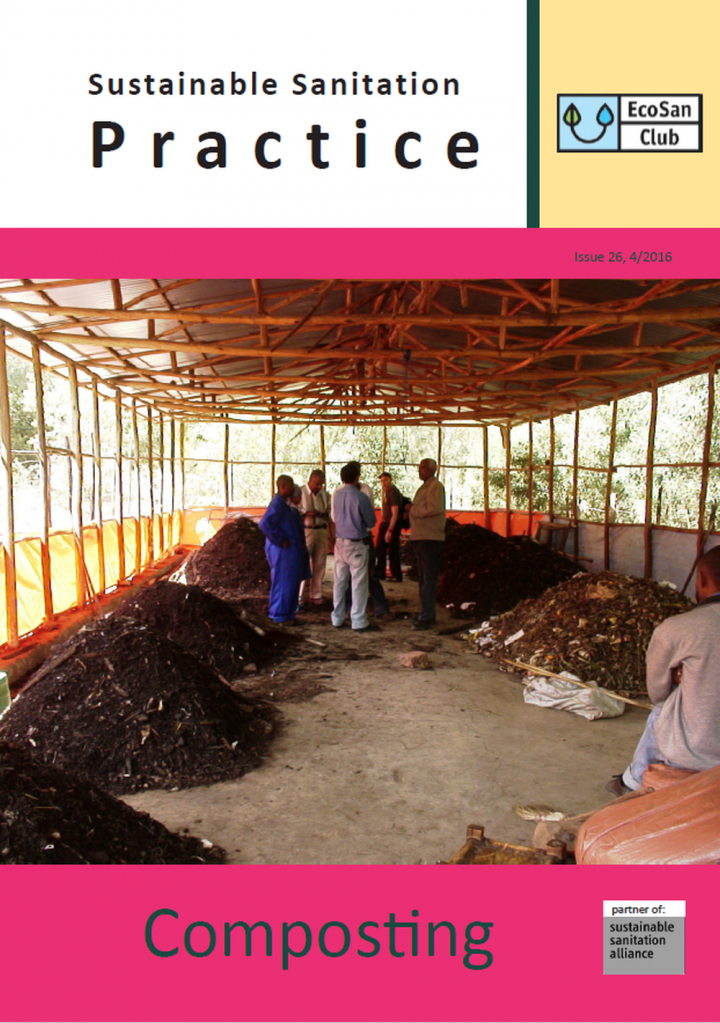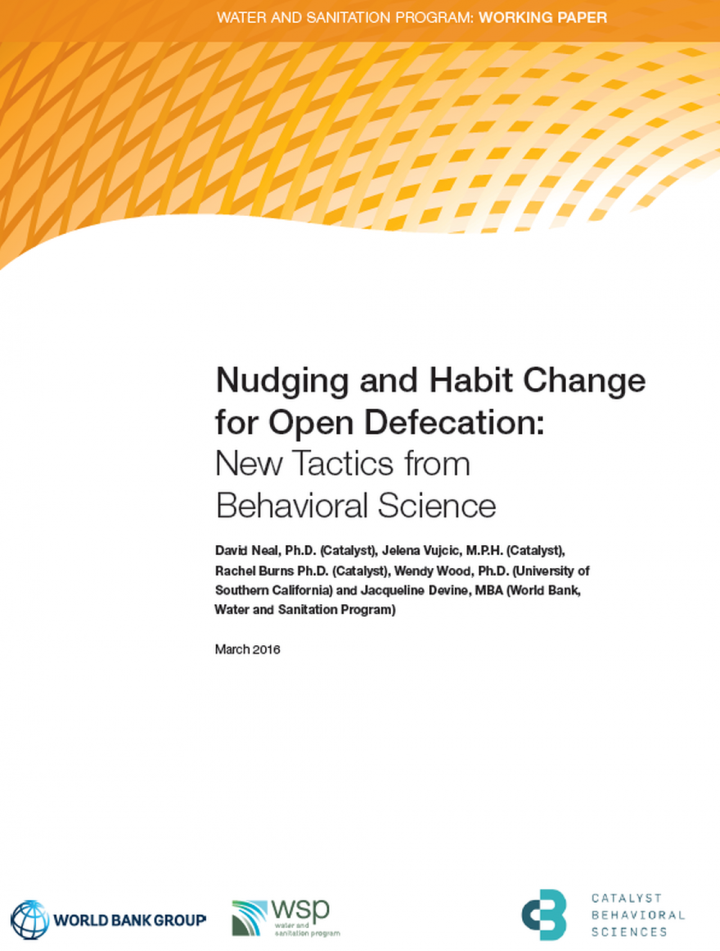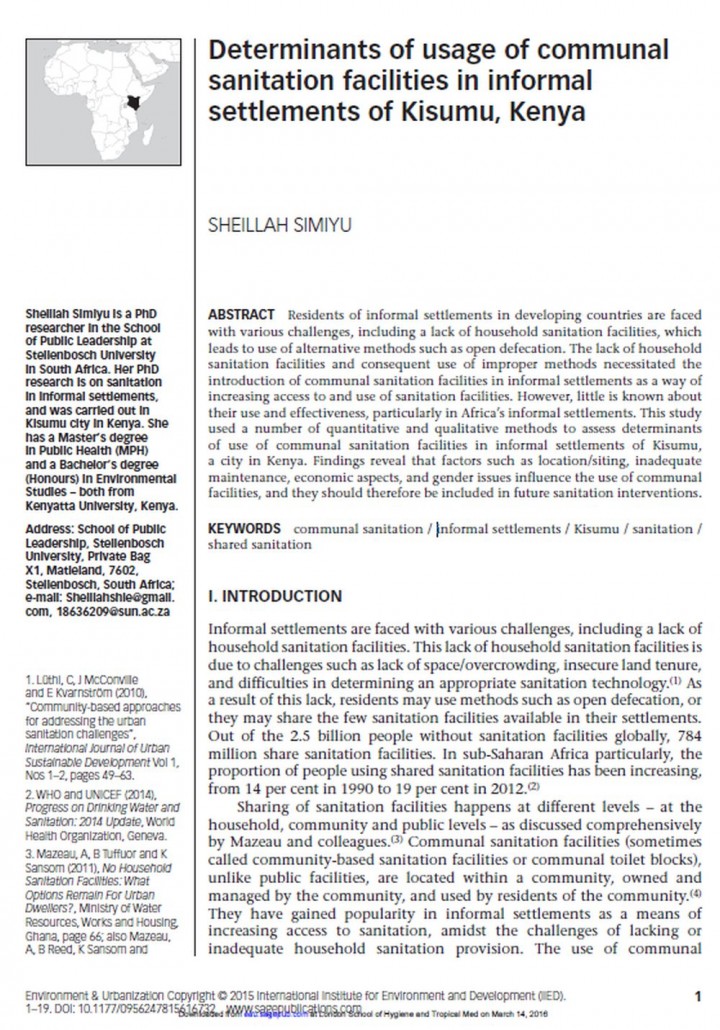Searching for information on Sanitation Workers?
The Sanitation Workers Knowledge + Learning Hub is the best source for all current news, trends, articles and updates on sanitation workers rights around the world.
Kampala city has a population of 1.5 million people with an estimated day population of 3.5 million. On average, two million people move through the city and need to use public/community sanitation facilities.
Section 35 of the KCCA Act 2010 mandates KCCA to provide safe sanitation facilities in communities. While fulfilling this obligation, KCCA and partners have constructed about 560 …
Kampala city has a population of 1.5 million people with an estimated day population of 3.5 million. On average, two million people move through the city and need to use public/community sanitation facilities.
Section 35 of the KCCA Act 2010 mandates KCCA to provide safe sanitation facilities in communities. While fulfilling this obligation, KCCA and partners have constructed about 560 …
Tirupati is situated in Chittoor district in the southern of the state of Andhra Pradesh with a total population of just under 375,000. The town is a pilgrimage center and attracts a total diurnal floating population of about 55,000. During religious festivals the diurnal floating population exceeds 100,000. In Tirupati it was estimated that 70% of excreta is managed safely while 30% of the …
In 2011, one in every four (26%) children under 5 years of age worldwide was stunted. The realization that most stunting cannot be explained by poor diet or by diarrhoea, nor completely reversed by optimized diet and reduced diarrhoea has led to the hypothesis that a primary underlying cause of stunting is subclinical gut disease. Essentially, ingested microbes set in motion two overlapping and …
This paper quantifies the factors explaining long-term improvements in child height for age z-scores in Bangladesh (1996/1997–2011), India (1992/1993–2005/2006), Nepal (1997–2011) and Pakistan (1991–2013). We apply the same statistical techniques to data from a common data source from which we have extracted a set of common explanatory variables that capture ‘nutrition-sensitive’ …
The implications of direct nutrition interventions on women’s nutrition, birth outcome and stunting rates in children in SouthAsia are indisputable and well documented. In the last decade, a number of studies present evidence of the role of non-nutritional factors impacting on women’s nutrition, birth outcome, caring practices and nutritional status of children. The implications of various …
Childhood stunting is the best overall indicator of children’s well-being and an accurate reflection of social inequalities. Stunting is the most prevalent form of child malnutrition with an estimated 161 million children worldwide in 2013 falling below 2 SD from the length-for-age/height-for-age World Health Organization Child Growth Standards median. Many more millions suffer from some degree …
This report draws attention to the neglected issue of anthropogenic chemical pollution in low- and middle-income countries.
The daily use of chemicals is omnipresent and only a few industrial sectors do not use chemical products. Consideration of chemical pollution issues are mainstream in the developed world where policy and practice engage in finding and implementing appropriate solutions. …
This City Sanitation Planning (CSP) package approach for Dar es Salaam was created in response to the need for a simple, fast and flexible tool for determining “which sanitation solutions go where”. CSP has the following advantages:
• Can keep up with rapid urban growth and is fast to update as new data (e.g. satellite imagery, open-street maps, etc.) becomes available
• Broad and …
The partial or total non-use of toilets, with some or all in a household defecating in the open, is a growing concern. Although all households may have a toilet, communities cannot remain open defecation free unless they are always used by everyone. This is not just an issue of maintenance and accessibility but also of social norms, mind-sets, and cultural preferences. The problem is widespread …
Lack of sanitation impacts on the rights to life and health, the right to education (through loss in school days, particularly for girls) and the right to dignity (UNRIC nd). The purpose of this issue of Frontiers of CLTS is to examine
Community-Led Total Sanitation (CLTS) in light of human rights: Does CLTS contribute to realising the right to sanitation and other inter-related rights? Are the …
“Introducing City Sanitation Plan: A Practitioners Manual” is a culmination of the long drawn process in introducing the importance of CSP for city development. It aims - to sensitize practitioners (key ULB level officials, decision makers, city engineers etc.) to the importance and significance of the CSP as a planning and guidance tool; to support them in understanding key concepts of the …
The Centre for Science and Environment (CSE) organised a two day workshop on “Mainstreaming Citywide Sanitation: Opportunities and Challenges for Excreta Management” from April 4-5, 2016 in New Delhi. The objective of the workshop was to promote active exchange of experiences of national and international opportunities and challenges in excreta management. The workshop was attended by over …
Besides sanitation, solid waste management plays an important role in improving the hygienic conditions in cities. There are several strong links between sanitation and solid waste management. In sanitation systems without sewers, urine, faecal matter and faecal sludge have to be collected from the single households such as solid waste. Faecal matter as well as sludge from wastewater treatment …
The WASH ePaper is an online magazine published at regular intervals in German, English, French and Spanish. Each issue takes a closer look at a current key issue in the water, sanitation and hygiene (WASH) sector and related areas. It also provides updates on forthcoming national and international events, highlights current publications and projects, and reports on news from the sector. The WASH …
A recent Lancet paper ranked handwashing in 21st place as a leading cause of Disability-Adjusted Life Years (DALYs) globally, stating: “The finding that no handwashing with soap is a global risk present in all regions is a reminder that this nexus of risks is relevant to all countries, not just the poorest.”
As such, it is important that we continue to seek to both learn more about …
In this working paper, we draw on basic scientific findings from psychology, cognitive science, and behavioral economics to propose a framework of 8 System 1 Principles to support the initiation and maintenance of OD behavior change. In doing so, we build from the general framework advanced in the World Bank Group’s (2015) World Development Report: Mind, Society, and Behavior, which emphasized …
Using government data, this brief reports on trends for SBM Gramin along the following parameters:
•Allocations and expenditures
•Physical progress of toilets built
•Expenditures incurred under Information, Education and Communication (IEC) activities
In addition, this brief reports findings from a fund tracking survey (PAISA) conducted in December 2015. The survey covered close to …
Residents of informal settlements in developing countries are faced with various challenges, including a lack of household sanitation facilities, which leads to use of alternative methods such as open defecation. The lack of household sanitation facilities and consequent use of improper methods necessitated the introduction of communal sanitation facilities in informal settlements as a way of …
Despite continuous financial efforts to improve the conditions in the country, Tanzania was off track to meet both the MDGs target on water and sanitation and the national MKUKUTA goals. Whilst the country reached a high level of latrine coverage (90%) during the Mtu ni Afya campaign of the 1970s, very little progress has been made since then to move the population up the sanitation ladder, from …
Like many other countries in the Global South, Malawi has failed to meet Millennium Development Goal (MDG) targets to improve access to sanitation. It has been estimated that only 25 percent of the country’s population has gained Access to improved sanitation since 1990 and access to it is a meagre 41 per cent, according to the latest Joint Monitoring Programme (JMP) Report (2015). By utilising …
Indonesia still faces several challenges in the areas of water, sanitation, and hygiene (WASH). Diarrhea remains a major killer of children and it is important to understand the local diarrhea transmission pathways to prioritise appropriate WASH interventions to reduce diarrhea burden. This study used a cross-sectional data set from a recent national household survey (the 2012 Indonesia …
This discussion paper reviews the extensive literature on sanitation to show that inadequate access to this basic service prevents the realization of a range of human rights and of gender equality. We recognize that “dignity” is a highly culture- and gender-specific term; we therefore argue that sanitation for all—sanitation that serves all genders equally—must be designed and planned …








































